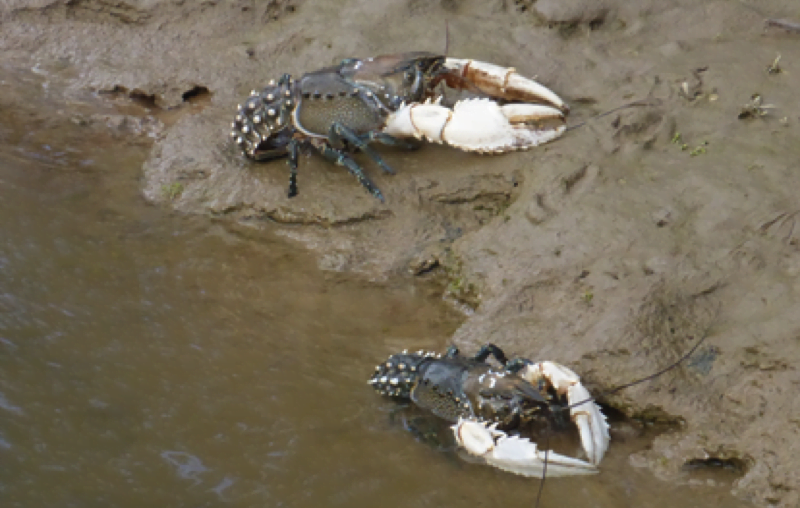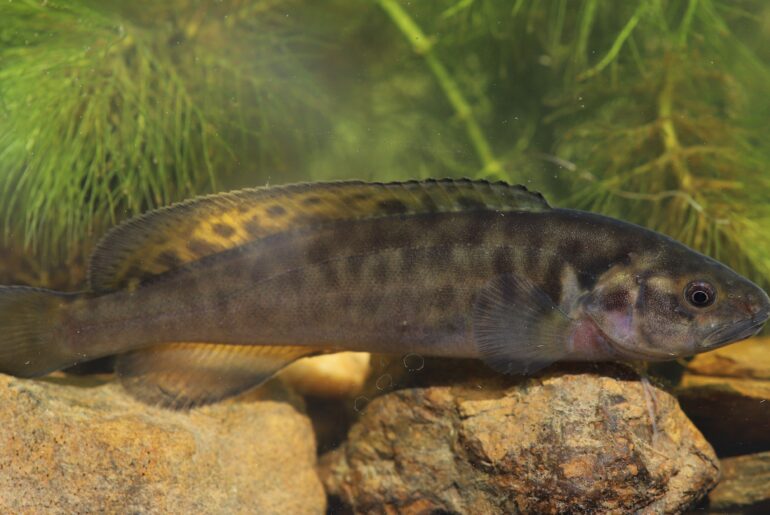In October 2014, a Murray Crayfish workshop was held to discuss the development of a collaborative project focusing on conservation of the species (Euastacus armatus) in the southern Murray‐Darling Basin. The species is listed as vulnerable in NSW and the ACT, threatened in Victoria and protected in SA. Twenty six stakeholders attended the workshop, from government departments in NSW and Vic, universities and recreational fishers including the NSW Council of Freshwater Anglers. The workshop provided guidance for a new collaborative project between NSW DPI (Marty Asmus and Dean Gilligan) and Aquasave – NGT (Nick Whiterod and Sylvia Zukowski) with support from ARI (Charles Todd) and Melbourne University (Adam Miller). Project funding is from NSW fishing licence fees, Murrumbidgee LLS, Murray LLS, the Victorian DEPI and Victorian fishing licence fees.
The workshop identified the following issues as important for the project to address:
- Water quality – agricultural chemicals, blackwater events, droughts.
- Diseases/parasites.
- Translocations – can we repopulate depleted areas?
- Habitat – flow, snags, substrate, food resources.
- Flow regimes – flow requirements, river regulation.
- Climate change – changes to habitat, temperature, and flow availability.
In addition to the above issues, recreational fishers noted that regulations concerning Murray Crayfish are among the most conservative of any recreational fishery in Australia. It was agreed at the workshop that tightening fishing regulations further would not be a viable option and what was needed was further research to better understand the effects the following activities:
- Localised impacts – effect of large ‘fishing camps’ (eg in school holidays), comparison between fished/non-fished areas
- Size and sex ratios – taking only males may reduce the breeding population of larger males.
- Illegal harvest – the reduced season/areas may lead to more illegal fishing activity.
- Open season timing – current open season is in breeding season, is this appropriate?
- Catch-release fishery – not really a viable proposition.
- Harvestable slot length limit – are current limits adequate?
Research priorities
Throughout the workshop, a range of research priorities addressing the issues outlined above were identified and these are summarised below:
- Distribution – continue surveying across reaches to assess the status of species;
- Critical flow requirements – for larva/juveniles/adults, winter/summer
- Environmental tolerances – seasonally, age/sex sensitivities to dissolved oxygen, acidity, agrcultural chemicals, salinity and temperature.
- Recreational fishery – assessment of fishing effort/harvest rates within the current regulations (open reaches). Assessment of illegal harvest rate within closed reaches?
- Habitat requirements – for different life stages, critical refuge areas?
- Reproduction/recruitment/
juveniles – is recreational fishing impacting on the population structure/ sex ratios and influencing the reproductive output in different river reaches and waterways? What are the mechanisms by which larvae disperse (drift dependent?) and settle into rearing habitats (as well as the location of these habitats)? What are the habitat requirements of smaller (<40mm) crayfish? - Capacity for recovery – juveniles are rarely seen, where do they live? What are the dispersal and movement patterns of juvenile and adult crayfish in lowland reaches? Age and growth rates are not well studied across their distribution.
- Food resources – the broad diet of juveniles/adults is known but unclear how diet changes over year, across regions and with different life stages. Are floodplain connectivity events important to provide food resources? How do Murray crayfish utilise biofilms on snags and how does reduced snag availability influence food resources?
The next steps
The following actions planned over the next year:
- Development and implication of a population (computer) model
- Finalise genetic assessment
- Explore possibility for recreational fisher involvement in monitoring
- Conduct fisher forums
- Commence benchmarking of Victoria waterways
To read the full report please follow this link.
This post is modified from material provided by the Department of Primary Industries for the Freshwater Fishers email newsletter. Supporters of the workshop included the Nature Glenelg Trust and NSW Department of Primary Industries.
Related stories
Fishers work with scientists to help monitor Murray crayfish



